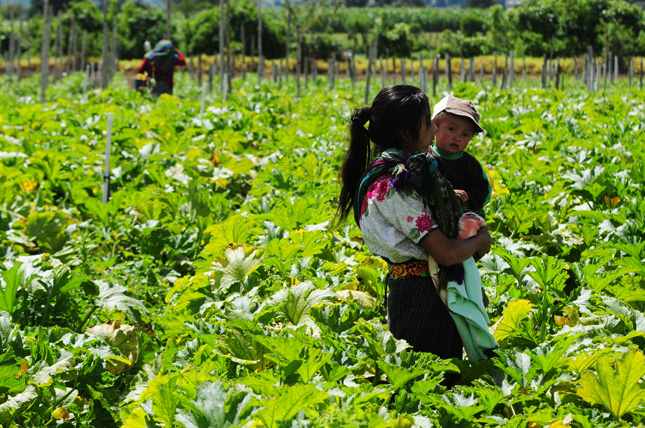-
Beyond Violence: Drought and Migration in Central America’s Northern Triangle
April 12, 2018 By Carrie Seay-Fleming
Starting in 2014, the number of migrants from Central America’s Northern Triangle—Guatemala, El Salvador, and Honduras—surged, with border apprehensions increasing fivefold from 2010-2015. While apprehensions have declined from their peak, emigration from these countries has not necessarily slowed, and the conditions the migrants are seeking to escape have not changed. Experts blame the region’s widespread criminal violence for spurring migration. But the Northern Triangle countries also share similar ecology, staple crops, and vulnerability to climate events. While environmental and natural resource factors are just part of the complex picture, understanding how they intersect with other migration drivers is key to creating and implementing effective policy responses.
Reconsidering the Violence-Migration Connection
Some research suggests that environmental factors—which have been largely neglected in media and policy discussions of the surge—has been a significant driver of Central American migration to the United States. People living in the Northern Triangle’s Dry Corridor region, which is highly prone to drought, are largely dependent on smallholder agriculture for their livelihoods. More than 50 percent of Central American migrants apprehended by Mexican authorities reported they worked in agriculture.
A 2012-2014 outbreak of coffee rust disease—la roya—destroyed coffee crops across Central America, hitting smallholder farmers and coffee workers in the Northern Triangle countries especially hard. The disease has a limited temperature range, but an increase in nighttime temperatures in coffee-producing areas has allowed coffee rust to flourish at higher altitudes. And beginning in 2015, an El Niño event led to two years of drought—described as “one of the worst on record” by the Food and Agriculture Organization—that devastated crop losses and dramatically increased food insecurity.
A 2017 World Food Program study found that nearly half of the people they interviewed were food insecure—a new high for the region. Three-quarters of households resorted to emergency coping strategies, like selling land. In areas most affected by El Niño, migrant households whose members had left the country between 2014 and 2016 cited “no food” as the most important reason to emigrate.
37 percent of adult respondents in El Salvador considered migrating in the last 12 months specifically due to security concernsThese factors suggest that the current theory blaming criminal violence for the surge may be incomplete or too simplistic. The violence-migration connection varies by country: Survey data from the 2017 Latin American Public Opinion Project demonstrates that 37 percent of adult respondents in El Salvador considered migrating in the last 12 months specifically due to security concerns. In contrast, only 17 percent of Guatemalan adults agreed with the same statement. Another study of unaccompanied child migrants found that only 8 percent of Guatemalans cited violence as a motive for migrating, compared to 39.5 percent of Salvadoran minors.
Paradoxically, however, most of the unaccompanied minors apprehended at the U.S. border in 2016 arrived from Guatemala. Violence in Guatemala, in contrast to El Salvador and Honduras, is highly concentrated in two areas, around the capital and in the Peten region. Together, these regions are the origin of only 20 percent of Guatemalan emigrants. Eighty percent of migrants from Guatemala originate from other rural departments, many of which have homicide rates comparable with the United States. El Salvador and Honduras have less regional variability and thus greater overall exposure to violence—although the number of migrants from these countries are lower.
Guatemala also has higher rates of food insecurity than El Salvador and Honduras. Almost 1 million of the 1.6 million Central Americans estimated to be moderately or severely food insecure are Guatemalan. Indeed, Guatemala has some of the highest rates of poverty, food insecurity, and malnutrition in all of Latin America, which are now further intensified by climate events.
These national differences indicate that rates of violence alone cannot be responsible for the migration from this region. Considering climate impacts on food security may help to explain why Guatemala, the country with the lowest incidence of violence, sent the most unaccompanied minors. Incorporating environmental pressures into our analysis of Central American migration will improve our understanding of the complex processes at play.
Push Vs. Pull: Designing Effective Responses to the Migration Crisis
Policymakers in the United States often focus on the “pull” factors of migration—the factors that draw migrants to the country. This emphasis ignores the reality that migrants, who are often reluctant to leave their homes, are driven by powerful “push” factors that can include both economic conditions and violence.
Policymakers seeking to address migration pressures should consider these push factors when designing their responses to the migration crisis. Efforts to untangle the mixed motives for migration will benefit from engaging researchers, NGOs, and humanitarian agencies studying conditions in the sending countries. Policymakers should also seek to protect migrants at risk of violence and establish criteria for incorporating climate-related migrants in this framework.
National differences should guide responses. In Honduras and El Salvador, violence is clearly a major issue driving migration. In Guatemala, mitigating climate-related food insecurity should be a priority. These policy responses must as be diverse and multilayered as the motives of the migrants themselves.
Carrie Seay-Fleming is a researcher at the University of Colorado. Her work focuses on understanding the social, environmental and health challenges of the rural poor with a geographic focus on Latin America.
Sources: Council on Foreign Relations, The Dialogue, Food and Agriculture Organization of the United Nations, Food Security, International Organization for Migration, Journal on Migration and Human Society, U.S. Customs and Border Protection, World Bank, World Food Programme
Photo Credit: Mother and child on a farm in Chimaltenango Guatemala, August 2009. Photo by Maria Fleischmann / World Bank.
 A Publication of the Stimson Center.
A Publication of the Stimson Center.



